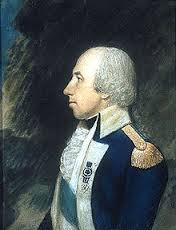Get Today in Masonic History into your Inbox. Sign up today for one of our email lists!
Need an article for your Trestleboard/Newsletter see our Use Policy
Rufus Putnam Passed Away

Today in Masonic History Rufus Putnam passed away in 1824.
Rufus Putnam was an American soldier.
Putnam was born in Rutland, Massachusetts on April 9th, 1738. Putnam's father passed away when he was only 6 or 7 years old. For a brief time he lived with his paternal grandfather until his mother remarried.
In 1757, Putnam joined a Connecticut regiment to fight in the French and Indian War. During the war Putnam saw combat in the Great Lakes Region and near Lake Champlain. He left the regiment in 1760 and moved to New Braintree, Massachusetts where he worked as a millwright from 1761 to 1768.
During Putnam's time as a millwright he studied surveying. In 1769, Putnam became a farmer and surveyor. In 1773, Putnam traveled with his cousin to the area near, what is now, Pensacola, Florida. There they surveyed the lands in the area and along the Mississippi which had been promised to veterans of the French Indian War by the British crown.
In 1775, after the battle of Lexington and on the same day, Putnam enlisted in one of Massachusetts first Revolutionary regiments. He was later commissioned as a lieutenant colonel. Drawing from his time as a millwright, Putnam began constructing fortifications. His fortifications helped secure, West Point, Providence and Long Island.
General George Washington appointed Putnam as the Chief of Engineers of the Works of New York. He was later promoted to engineer and the rank of colonel. He resigned when his proposal to establish a national core of engineers was rejected by the Continental Congress.
Putnam reenlisted with the Northern Army and commanded two regiments at the battle of Saratoga. He continued to work on fortifications, particularly at West Point.
In 1780, Putnam returned to Rutland, Massachusetts where he bought and settled on a farm confiscated from loyalists during the Revolutionary War.
Putnam was a strong advocate of land grants for veterans. He was one of the authors of the Newbergh Petition requesting Congress create land disbursements. He also created the Ohio Company of Associates whose purpose was the purchase of western lands specifically the Northwest Territory. The company bought 1,000,000 acres of land north of the Ohio River.
In 1788, Putnam led a group of veterans to the land. The area eventually become Ohio. In 1792 and 1793, Putnam served as a brigadier general against native American tribes who had originally occupied the land. The tribes were eventually defeated.
In 1796, Putnam was appointed by President Washington to be the first Surveyor General of the United States. He held the position until 1803.
Putnam served in a variety of positions during the forming of Ohio as a state. He was a delegate to the Ohio Constitutional Convention, a judge and for two decades a trustee of Ohio University.
Putnam died on May 4th, 1824.
Putnam was raised a mason in 1779 as a member of American Union Lodge, an Army lodge, in New York. In 1790 at Campus Martius, the second fortification built in Marietta, Putnam was one of 10 masons who petitioned to have American Union Lodge reconstituted. On January 7, 1808, at a convention to establish the Grand Lodge of Ohio, Putnam was elected as Right Worshipful Grand Master. This made Putnam the first Grand Master of the Grand Lodge of Ohio.
This article provided by Brother Eric C. Steele.

